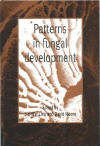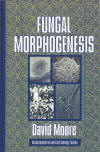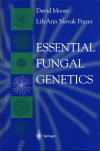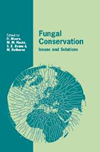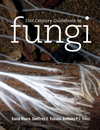13. Mathematical modelling
We think there is no reason why the ‘rules’ which govern morphogenesis in fungi should not be established. From those rules and a few dimensions, times and rate values a mathematical expression to describe the entire morphogenetic process could emerge. This is a nice idea, but where to start is the problem. We started two ways. In one approach we attempted to create three-dimensional models of fungal tissues using laser confocal microscopy and reconstruction from serial sections to establish 3-D visualisations of the geometrical arrangement of the hyphal components of fungal tissues which can be inspected from within. The intention was to use these (computer) visualisations to extract geometrical measurements for accurate data sets describing hyphal dimensions, distributions and branch angles within representative tissue (Moore, Reeve, Meškauskas, Sánchez & Chiu, 2000). We soon appreciated that this approach was doomed to failure at the time because the observation technique was destructive of the tissue under examination. The essential time dimension of developing tissue was lost and the outcome was just a different way of visualising a dead lump of tissue. As confocal microscopy develops this situation may improve; but around the year 2000 we had to find a different approach.
That alternative developed out of the research on gravitropism which is described above (see ‘Gravitropism as a morphogenetic model’ above). Causing a mushroom stem to bend in response to a tropic stimulus is a suitably simple experimental study of a developmental process. The experimenter can choose when to apply the stimulus, it is easily replicated and reaction and response times can be measured readily. Also, the response itself can be measured so the numerical demands of mathematical modelling can be satisfied. Even more important is that a change in orientation is a non-invasive stimulus. Our experiments coupled video observation and image analysis to get detailed descriptions of the kinetics. We varied exposure to gravity by using clinostats and employed a variety of microscopic observation techniques to make quantitative observations.
Observation of live tissue showed that bending rate of a mushroom stem is determined by the balance between signals from gravity (a function of the angle of the stem) and curvature compensation detectors (a function of the local amount of curvature in the tissue). This was reduced to a mathematical model. Initially, we produced a mathematical description of mushroom stem gravitropic bending which successfully imitated on computer displays the process in live fruit bodies of both Coprinopsis cinerea and Flammulina velutipes (Stočkus & Moore, 1996; Moore & Stočkus, 1998).
This model was limited (being imitative rather than predictive) but it did focus attention on the need for data on detection-level thresholds, angle-response and acceleration-response relationships in fungal fruit bodies. The imitative model also revealed (by failing to imitate it) that curvature compensation occurred in Coprinopsis cinerea; the stems of which rarely overshot the vertical or oscillated around the vertical. In other words, as the stem reached maximum curvature to bring its apex from the horizontal to the vertical orientation, something (which we called curvature compensation) acting as a straightening mechanism began to reduce the 'curving tendency' so that the apex was brought smoothly to the vertical without overshoot. Using video observations we established how the distribution of local curvatures changed during the mushroom stem gravitropic reaction by converting stem images to non-linear polynomial regressions. From the resulting equations the patterns of changing local curvature for 50 subsections per stem during 400 min of gravitropic reaction were calculated. It was observed that stems fixed horizontally with a pin through their base first bent upwards from the apex, but later the curvature of this part decreased, and in the late stages the apex became nearly completely straight again. Subsections, located about one third of stem length from the base determined the main part of the final curvature of the fully re-oriented stem (Meškauskas, Moore & Novak Frazer, 1998). We hypothesised that a reorientation signal arises in the apex and is propagated towards the base; this propagation (signal origin and transmission) depending on the local angle of each subsection of the stem. The signal transmission equation which was derived from these new data was incorporated into a mathematical model that was able to generate predictively shapes of the bending stem that coincided with experimentally observed images.
The assumption that the mushroom stem has the ability to undergo autonomic straightening enabled a mathematical model to be written that accurately mimics the gravitropic reaction of the stems of Coprinopsis cinerea (Meškauskas, Novak Frazer & Moore, 1999). The straightening mechanism is called curvature compensation here, but is equivalent to the 'autotropism' that often accompanies the gravitropic reactions of axial organs in plants. In this revised local curvature distribution model of mushroom stem gravitropism, local bending rate is determined by the difference between the 'bending signal' (generated by gravitropic signal perception systems) and the 'straightening signal' (proportional to the local curvature at the given point). The model describes gravitropic stem bending in the standard assay with great accuracy but has the virtue of operating well outside the experimental data set used in its derivation. For example, the mathematical model was predictive and successfully described the gravitropic reaction of stems treated with metabolic inhibitors, confirming the credibility of the model and indicating possible links between the functions of the equations and actual physiological processes.
Interestingly, this model was found to produce accurate simulations of the gravitropic reaction of wheat (Triticum aestivum) coleoptiles (Meškauskas, Jurkoniene & Moore, 1999) implying universality of application of this model to axial organs of both plants and fungi. The key feature that enables of the mathematical model to approach universal applicability is the assumption that the stem has an autonomic straightening reaction (curvature compensation or autotropism). Applicability of the model to any given tissue depends on the values given to its parameters, and this reveals three major differences between the gravitropic reactions of wheat coleoptiles on the one hand and Coprinopsis mushroom stems on the other. First, in Coprinopsis, the capacity for autonomic straightening is much more concentrated in the apical region of the stem. Second, local perception of the gravitropic signal, which is necessary for exact simulation in Coprinopsis, is not needed in wheat coleoptiles (the corresponding constant in the model can be set to zero). Third, the transmission rate of the gravitropic signal is about seven times faster in wheat coleoptiles than in the mushroom stem.
Our work on gravitropism in mushroom fruit bodies had always been intended as an experimental approach to a better understanding of fungal developmental biology in general. Having developed an entirely realistic mathematical model of fungal gravitropism, we decided to extend that model to produce a mathematical model that is sufficiently sophisticated to produce a realistic visualisation of fungal hyphal growth patterns. What we were striving for was a cyberfungus that can be 'grown' by computer and used for experimentation on the theoretical rules that might govern hyphal patterning, hyphal interactions, and tissue formation and organ development by actually visualising the virtual hyphal growth patterns that result from different regulatory scenarios (Moore & Meškauskas, 1999a; Moore & Meškauskas, 1999b).
This expectation is based on the fact that the fundamental cellular component of fungi is the hypha, which is a polarised cylindrical structure with a chitinous cell wall. Kinetic analyses show that fungal filamentous growth can be interpreted on the basis of a regular cell cycle, and the essential starting point for any attempt to develop an understanding of fungal networks is a clear statement of the most crucial hyphal growth rules characterising that cycle. These are as follows (Meškauskas, McNulty & Moore, 2003):
- Extension growth occurs only at the hyphal apex;
- Cross walls always form at right angles to the long axis of a hypha;
- Nuclear division is not necessarily linked to cell division;
- Formation of hyphal branches is the only way to increase the number of growing points.
An important biological observation is that a fungal mycelium has a number of alternative developmental pathways open to it:
- continuation of hyphal growth;
- production of asexual structures;
- progress into the sexual cycle.
These are not strict alternatives because a mature culture may express all of these possibilities at the same time. This is interpreted to mean that genetic control must be localised.
The biological consequence of these common observations is that, for the fungi, hyphal branch formation is the equivalent of cell division in animals, plants and protists: no matter how many nuclear divisions occur, and no matter how many cross walls are formed in a hypha there will be no increase in the number of hyphal tips unless a branch arises. The position of origin of a branch, and its direction and rate of growth are the main formative events in the development of fungal tissues and organs (Moore, McNulty & Meškauskas, 2003).
We developed a mathematical model and computer program, which we call the Neighbour-Sensing model. This is a new, vector-based, mathematical model and computer program that provides a life-like tool enabling experimentation on fungal growth by visualising virtual hyphal growth patterns. The Neighbour-Sensing model ‘grows’ a simulated mycelium in the user's computer using branching rules decided by the user. The program calculates everything else it needs to generate a mycelium. As the cyberhyphal tips grow out into the (three-dimensional) modelling space the model tracks where they’ve been and those tracks become the hyphal threads of the cybermycelium. But that’s not all. Most mathematical models leave you with the mathematics, and not everyone is entirely comfortable with that. We developed a fully-fledged Java™ application with user-friendly interface to interact with the mathematical model and an on-screen, 3-dimensional visualisation. The result is that you can see the cyberfungus growing on the computer monitor; interact with it, pause the visualisation, change the growth characters and produce complex morphologies (Moore, 2004).
The ability of the Neighbour-Sensing model to produce extremely realistic simulations comes from the fact that the computer hyphal tips are given life-like characteristics. The essential part of the Neighbour-Sensing model is a hyphal tip able to venture into cyberspace itself, as an active agent following the rules it has been given. Each tip has position in three-dimensional space, it has a growth vector and it has length, and an ability to branch. The program starts out with just one hyphal tip, which is equivalent to the fungal spore. Each time the program runs through its algorithm the tip advances by a growth vector (initially set by the user) and may branch (with an initial probability set by the user). These simple features (or ‘parameters’), where direction of growth is random, are sufficient to result in a spherical mycelial colony (circular if growth is restricted to a flat plane) (Meškauskas, Fricker & Moore, 2004).
So the first conclusion of the modelling experiments is that the characteristically circular colony of fungi does not need to be contrived - it is a natural outcome of the exploratory apical growth of fungi. Real fungi, however, do not grow in random directions. Real hyphal tips grow in accordance with their reactions to the effects of one or more tropisms. In this Neighbour-Sensing mathematical model of hyphal growth the growth vector of each virtual hyphal tip depends upon values derived from its surrounding virtual mycelium. Effectively, the virtual hyphal tip is sensing the neighbouring mycelium.
Tropisms are implemented in the Neighbour-Sensing model using the concept of a field to which growing hyphal tips react. In the real physical world, the field might be an electrical field (that is, a particular distribution of charged ions) for a galvanotropism, the Earth’s gravitational field for a gravitropism, or a chemical diffusion gradient. In the mathematical model, the same basic field equations can be used for all, the different tropisms being distinguished by the different physical characteristics ascribed to the field. The published model features seven tropisms:
- negative autotropism, based on the hyphal density field;
- secondary long range autotropism (that attenuates with either direct or inverse proportionality to the square root of distance);
- tertiary long range autotropism, which attenuates as rapidly as the negative autotropism but can be given a large impact value;
- two galvanotropisms based on the physics of an electric field produced by the hypha which is parallel to the hyphal long axis (biologically, this could be based on ion gradients produced by ion pumps in the membrane);
- gravitropism, which orients hyphae relative to the vertical axis of the user’s monitor screen;
- horizontal plane tropism, which provides a way of simulating colonies growing in or on a substratum like agar or soil by imposing a horizontal geometrical constraint on the data space the cyberhyphal tips can explore. The user can determine how strongly the hyphal tips are limited to the horizontal plane, and the permissible layer thickness.
What does it do? The Neighbour-Sensing model provides the user with a set of abstract mathematical tools which amount to a culture of a newly arrived fungus. What do you want to do with it? The rate of growth of the cyberfungus is up to you and the power of your computer, so you could do more experiments in an afternoon’s computing than you could do in a year in the laboratory. There might be some experiments that are impossible, or at least very difficult, to carry out with live fungi. Could you measure the total length of mould mycelium in a leaf as it develops an attack of mildew? Yes, probably, if you cut up the leaf and use a lot of microscopy - but by the time you’ve finished the leaf’s dead! Yet a computer program can easily calculate the total length of hyphae – and how many branches, and show you where they all are; and do it again 5 minutes later, and 5 minutes after that. Something else you could try, is to find out how long it takes a fungal pathogen to grow across a forest floor to attack an entire forest. You could do that in a real forest. If you live long enough, that is, because it might take 50, 60 or 70 years in a real forest. But set up a good computer model and it will give you the results tomorrow; with a complete set of distribution maps! We have already used the Neighbour-Sensing model to simulate a variety of branching patterns in three dimensions (Moore, McNulty & Meškauskas, 2003; Moore, McNulty & Meškauskas, 2004). Most significantly, we have shown that complex fungal fruit body shapes can be simulated by applying the same regulatory functions to all of the growth points active in a structure at any specific time. No global control of fruit body geometry is necessary. No localised regulation is necessary. The shape of the fruit body emerges from the concerted response of the entire population of hyphal tips, in the same way, to the same signals (Meškauskas, McNulty & Moore, 2004).
In a different series of experiments we showed how the Neighbour-Sensing model can simulate growth in semi-solid substrata like agar or soil, enabling realistic simulation of mycelial colonies of filamentous fungi grown in ‘ Petri-dish style ’ experimental conditions. A measurement and logging system within the program maintains basic statistics about the mycelium it is simulating, which facilitates kinetic experimentation. We also show that the Neighbour-Sensing model can generate sufficiently realistic cord-like structures simulating fungi of the forest floor to provide a means to model the morphogenetic effects of a variety of factors, from environmental and nutritional features to mutations, in experimentally realistic situations that would be difficult or impracticable in vivo (Meškauskas, Fricker & Moore, 2004).
The Neighbour-Sensing model of hyphal growthYou can experience all of our models for yourself elsewhere in this website, in the World of Cyberfungi section [CLICK HERE if you want to dive in now]. For an easy introduction to gravitational and hyphal growth modelling I recommend that you start with our 'Modelling Tropisms' page [CLICK HERE (opens in a new window, close that window to return to this page)] |
What might it do in the future? We have already included ‘substrates’ in the data space causing positive or negative tropisms for the growing mycelium; a horizontal plane tropism that provides a way of simulating colonies growing in or on a substratum like agar or soil by imposing a horizontal constraint on the data space the cyberhyphal tips can explore; and created three categories of hypha – standard hyphae are those that start the simulation, leading hyphae can emerge from the colony peripheral growth zone to take on a leading role, and secondary hyphae are branches that can arise late, far behind the peripheral growth zone, when mature hyphal segments resume branching to in-fill the older parts of the colony. The Neighbour-Sensing model is now sufficiently advanced for parameters to be defined that simulate specific in silico cyberfungi. Do it for one – do it for many: establish a ‘culture collection’ of cyber species that can be chosen from a menu like the characters of a computer game. The potential utility of these cyberspecies is that they provide a means to model the morphogenetic effects of a variety of factors, from environmental and nutritional features to mutations, in experimentally realistic situations, offering a valuable addition to the experimental toolkit of all those interested in fungal growth and morphology.
If it is possible to include hyphal anastomosis this would enable the model to generate biologically inspired networks and so provide a tool to analyse these networks to yield information about connectivity, minimum path length, etc. Since the Neighbour-Sensing model ‘grows’ a realistic mycelium and tracks all of the hyphal segments so generated, looking further into the future, it should be possible to assign to those hyphal segments the algebraic characteristics defined to describe substrate uptake, utilisation and translocation kinetics. With these features added, the cybermycelium will follow realistic rules to grow; it will use substrates realistically; produce products realistically; and translocate metabolites with the same kinetics as in live fungi. [TOP]
Updated December 7, 2016



